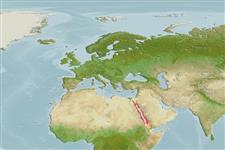Actinopterygii (ray-finned fishes) >
Perciformes (Perch-likes) >
Caesionidae (Fusiliers) > Caesioninae
Etymology: Caesio: Latin, caesius, bluish-grey, 1835; it is the same name given to the silvery metal (Cs) (Ref. 45335).
Environment / Climate / Range
Ecology
Marine; reef-associated; non-migratory; depth range 2 - 25 m (Ref. 9710). Tropical, preferred ?; 31°N - 11°N, 32°E - 45°E (Ref. 402)
Indian Ocean: Red Sea to the Arabian Sea.
Size / Weight / Age
Maturity: Lm ? range ? - ? cm
Max length : 35.0 cm TL male/unsexed; (Ref. 402)
Dorsal
spines
(total): 10;
Dorsal
soft rays
(total): 14-15;
Anal
spines: 3;
Anal
soft rays: 12. With 4-5 scales on cheek; 21-24 predorsal scales; scaled dorsal and anal fins; narrow scaleless zone at dorsal midline interrupting Supra-temporal band of scales. Upper peduncular scale rows usually 11 (10-11); lower peduncular scale rows usually 14 or 15 (13-15). Most of body light to silvery blue, paler ventrally. Black blotch at the tip of each caudal-fin lobe bordered proximally by a white band. Presence of a small process on each ventrolateral surface of basioccipital for attachment of Baudelot's ligament. Post maxillary process single; posterior end of maxilla blunt.
Inhabits coastal areas, primarily on coral reefs. Forms large midwater aggregations and feeds on zooplankton. Oviparous, with numerous, small pelagic eggs (Ref. 402).
Life cycle and mating behavior
Maturity | Reproduction | Spawning | Eggs | Fecundity | Larvae
Carpenter, K.E., 1987. Revision of the Indo-Pacific fish family Caesionidae (Lutjanoidea), with descriptions of five new species. Indo-Pac. Fish. (15):56 p. (Ref. 1723)
IUCN Red List Status (Ref. 115185)
CITES (Ref. 94142)
Not Evaluated
Threat to humans
Harmless
Human uses
Fisheries: subsistence fisheries
More information
ReferencesAquacultureAquaculture profileStrainsGeneticsAllele frequenciesHeritabilityDiseasesProcessingMass conversion
Tools
Special reports
Download XML
Internet sources
